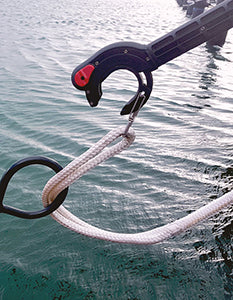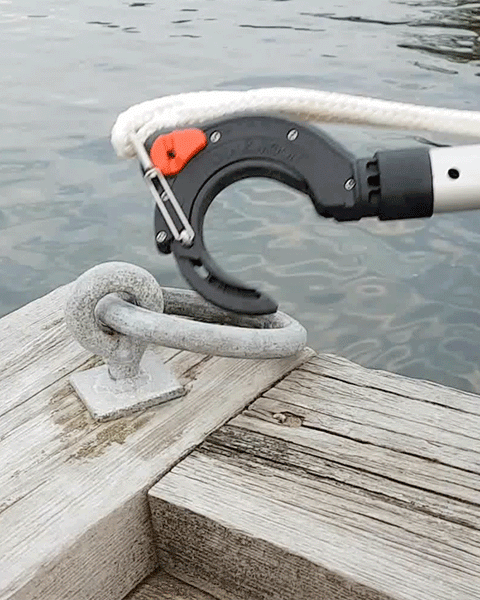
We have been mooring on Washington State Parks and DNR buoys for many, many years. Although we anchor more often, we find mooring buoys to be much easier and more convenient. The primary reason for this preference is our Hook & Moor works 100% of the time!
Lisa first saw the Hook & Moor at the Oakland Boat Show eight years ago. She was walking past the booth and saw the live demonstration. Like virtually everyone else that sees it in action for the first time, she stopped and said "do that again!" Other boaters were stopping, too. Before most people eventually figure out it is the ingenious design and exceptional engineering that allows the Hook & Moor to do its thing, the typical reaction is "it's like magic!" Which is exactly what Lisa said when she excitedly described it to me over the phone.
I was, of course, slightly skeptical. A boat hook that magically grabs a mooring ring, threads your line through it and brings it back to you in one easy, continuous motion?

She immediately brought one home.
Many boaters know the traditional way to pick up a mooring buoy, which is how we did it for years. You slowly approach the mooring from downwind. You then grab the ring on top of the buoy with your boat hook and pull it up to you on the bow, which pulls the actual anchoring chain up through the buoy with it. You then struggle to keep one hand holding the ring and chain up off the water while you drop your boat hook on the deck and then try to thread your mooring line through the ring. This can take more than one attempt.
Then there are the times you are simply unable to bring the ring up to the boat because it's stuck in the buoy due to marine growth on the chain. Yes, it has taken both of us a time or two to pull the ENTIRE buoy and chain up out the water in order to thread a line through it. And when your bow is almost seven feet over the water, that's not an easy thing to do!
Another much less safe method is to either slowly pass the buoy or back up to it until it is alongside the cockpit or swim step for a closer reach. The danger with this method is you then have a mooring chain uncomfortably close to your propellor.
There have been a few attempts over the years to develop a reliable mooring tool. This usually involved modifying a standard boat hook, often employing a messenger line. Some of these contraptions worked, some really didn't. None of them work as well - or as easily and consistently - as the Hook & Moor.
Since acquiring our Hook & Moor we have used it close to a hundred times, mostly on state park and DNR buoys. And, as we stated in the beginning, it has worked 100% of the time. Watch this short 41-second video and you'll see the different ways and scenarios where the Hook & Moor works:
There have been times when we have entered a busy bay or state park cove and motored over to one of the few remaining mooring buoys. And if you've been boating long enough, you know what happens. Everyone stops what they're doing to see how well the new guy does grabbing a mooring. With us, there's no drama whatsoever. Lisa pilots us up to the buoy (we have the "Marriage Saver" wireless headsets for communicating) and I simply hook the ring and pull our line back to the boat. Simple, and easy. One time we actually had a guy give us an ovation! We could hear him tell his wife, "did you see that?" Often, after a few minutes have elapsed and we're all tied up, a neighbor will come by in their dinghy to ask us what we used.
We can assure you, while it does indeed look like magic, it's a very well designed and engineered piece of boating gear. Each Hook & Moor is made of high quality materials. A sturdy combination of carbon/glass fiber reinforced PA, forged aluminum, and stainless steel. And, if you accidentally to drop it in the water, it floats. Additionally, if you lock the head in position, it can be used just like a traditional boat hook.

The Hook & Moor is available in three telescoping lengths: 6-feet, 8.2-feet, and 10.4-feet. When collapsed for storage, the 6 and 8.2-foot models are only 40 inches long, while the large model is just 49 inches long.
When determining which model is best for you, keep in mind the height of your bow/foredeck off the water. As we said, our foredeck is almost seven feet high, so we have the 10.4-foot model. You want the Hook & Moor to not only extend down to a mooring, but have some reach out as well. Also, they can be effectively "shortened" if needed, by extending just one or two of the telescoping lengths.
The price? These are not cheap, $35 throw away boat hooks. Starting at $165 for the 6-foot model ($199 for the 10.4-foot), these are exceptionally well designed tools for safely and easily securing a mooring buoy. But after you successfully use yours for the first time, it will quickly become one of your favorite pieces of gear on the boat.
Comments will be approved before showing up.

Memories are made on the water. Often it's the skipper's (Dad's) job to ensure everyone has a good time and arrives safely at the end of the day or journey. Usually the thanks Captain/Dad gets is in the form of satisfied, happy faces. Which is enough! We decided to take that one step further, however, and made a collection of 12 items that show just how much you appreciate everything he does.

As of today, Section 301 Tariffs have impacted more than 300 commonly used components, materials, and parts for recreational boats in the United States (source, National Marine Manufacturers Association). Even our little online store is beginning to see price increases and supply chain disruptions...

Darren OBrien
Author